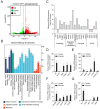Pseudomonas plecoglossicida infection induces neutrophil autophagy-driven NETosis in large yellow croaker Larimichthys crocea
- PMID: 39763642
- PMCID: PMC11701331
- DOI: 10.3389/fimmu.2024.1521080
Pseudomonas plecoglossicida infection induces neutrophil autophagy-driven NETosis in large yellow croaker Larimichthys crocea
Abstract
Neutrophil extracellular traps (NETs) are crucial for the immune defense of many organisms, serving as a potent mechanism for neutrophils to capture and eliminate extracellular pathogens. While NETosis and its antimicrobial mechanisms have been well studied in mammals, research on NETs formation in teleost fish remains limited. In this study, we used the large yellow croaker (Larimichthys crocea) as the study model to investigate NETosis and its role in pathogen defense. Our results showed that infection with Pseudomonas plecoglossicida could induce NETosis. To further explore the underlying mechanism, we performed transcriptome analysis and western blotting, which revealed that P. plecoglossicida triggers NETosis through activation of the autophagy pathway. Inhibition of autophagy significantly reduced NET production, highlighting its critical role in this process. Furthermore, our studies demonstrated that NETs exert a bacteriostatic effect, significantly suppressing the growth of P. plecoglossicida. Taken together, our findings reveal that autophagy regulates NETosis in large yellow croaker and underscore the essential role of NETs in bacterial defense, providing new insights into immune responses in teleost fish.
Keywords: Larimichthys crocea; Pseudomonas plecoglossicida; antibacterial; autophagy; neutrophil extracellular traps.
Copyright © 2024 Cao and Chen.
Conflict of interest statement
The authors declare that the research was conducted in the absence of any commercial or financial relationships that could be construed as a potential conflict of interest. The author(s) declared that they were an editorial board member of Frontiers, at the time of submission. This had no impact on the peer review process and the final decision.
Figures






Similar articles
-
Transcriptomic analysis reveals the role of MAPK signaling pathway in IgM+ B cells against Pseudomonas plecoglossicida infection in large yellow croaker (Larimichthys crocea).Fish Shellfish Immunol. 2025 Oct;165:110526. doi: 10.1016/j.fsi.2025.110526. Epub 2025 Jun 27. Fish Shellfish Immunol. 2025. PMID: 40582529
-
Unraveling the immune functions of large yellow croaker Tmem208 in response to Pseudomonas plecoglossicida: Insights from cloning, expression profiling, and transcriptome analysis.Fish Shellfish Immunol. 2024 Jun;149:109584. doi: 10.1016/j.fsi.2024.109584. Epub 2024 Apr 25. Fish Shellfish Immunol. 2024. PMID: 38670411
-
Characterization and Functional Analysis of Trim38 in the Immune Response of the Large Yellow Croaker (Larimichthys crocea) Against Pseudomonas plecoglossicida Infection.Int J Mol Sci. 2025 Apr 27;26(9):4150. doi: 10.3390/ijms26094150. Int J Mol Sci. 2025. PMID: 40362389 Free PMC article.
-
Autophagy-driven NETosis is a double-edged sword - Review.Biomed Pharmacother. 2020 Jun;126:110065. doi: 10.1016/j.biopha.2020.110065. Epub 2020 Mar 19. Biomed Pharmacother. 2020. PMID: 32200255 Review.
-
NETosis and Neutrophil Extracellular Traps in COVID-19: Immunothrombosis and Beyond.Front Immunol. 2022 Mar 2;13:838011. doi: 10.3389/fimmu.2022.838011. eCollection 2022. Front Immunol. 2022. PMID: 35309344 Free PMC article. Review.
Cited by
-
Antioxidants as Modulators of NETosis: Mechanisms, Evidence, and Therapeutic Potential.Int J Mol Sci. 2025 May 30;26(11):5272. doi: 10.3390/ijms26115272. Int J Mol Sci. 2025. PMID: 40508099 Free PMC article. Review.
References
MeSH terms
Supplementary concepts
LinkOut - more resources
Full Text Sources

